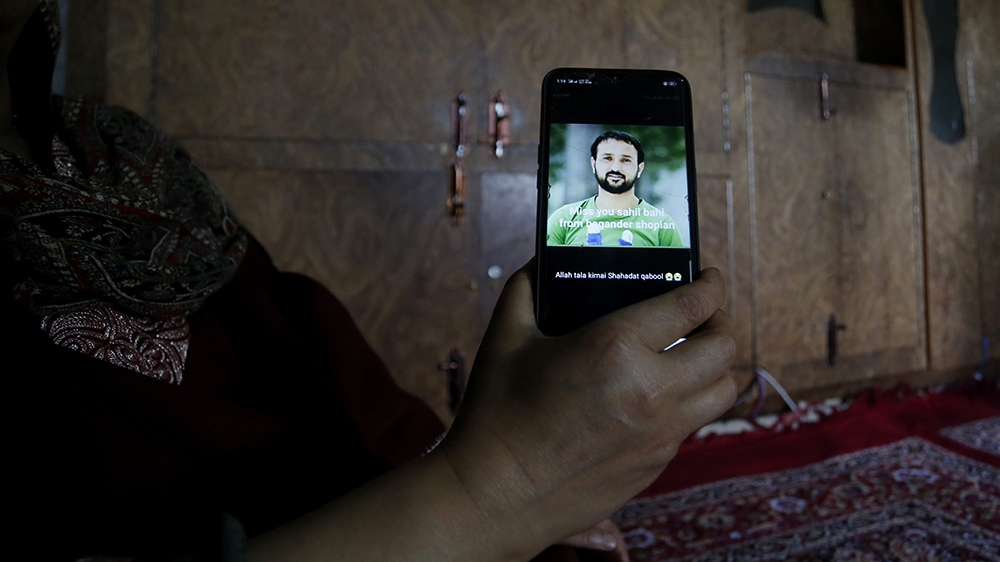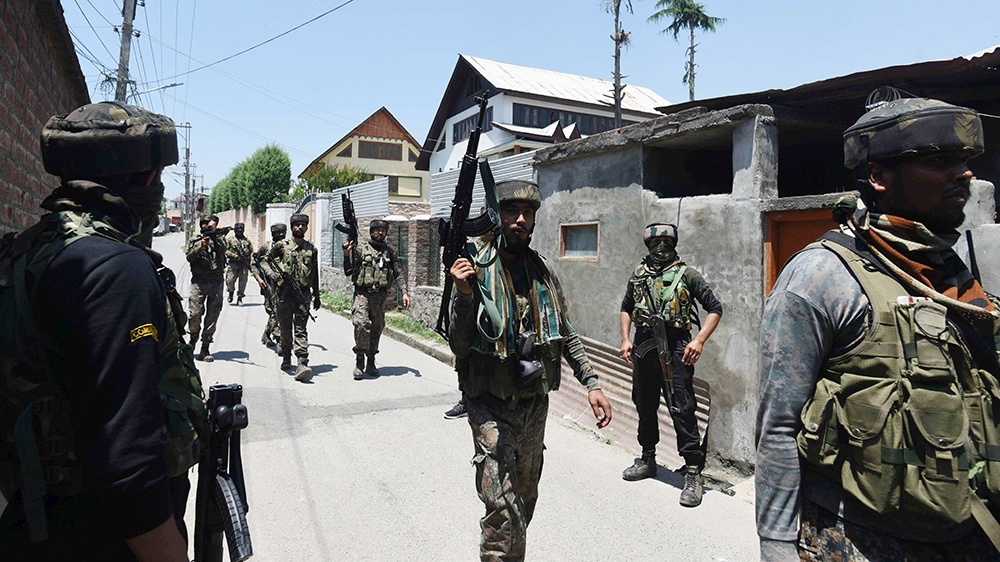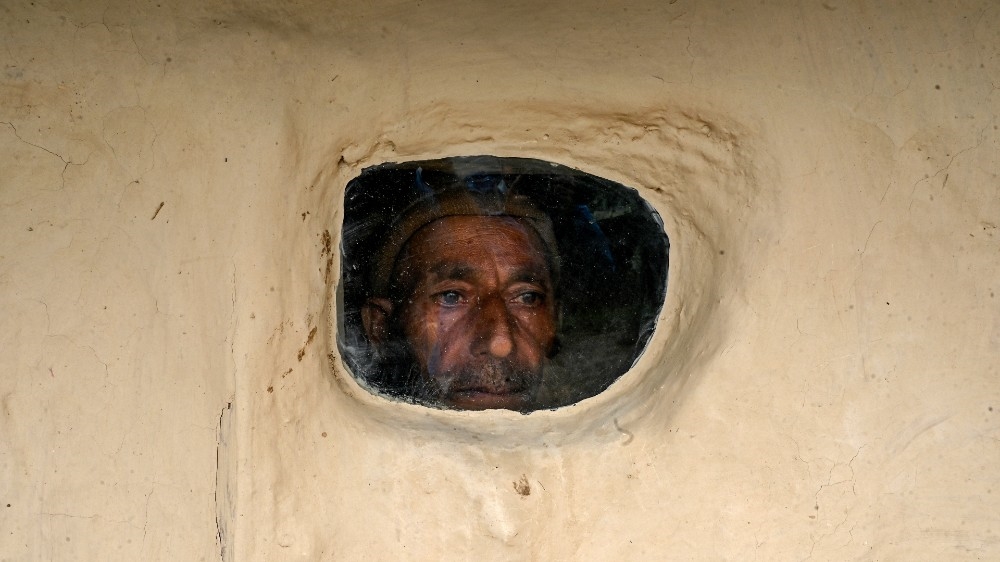Why a growing number of Kashmiri youth are picking up guns
Violence has seen an uptick as India’s governing party adopts a tough policy to deal with protests and armed rebels.

Shopian, Indian-administered Kashmir – Sajad Ahmad Beigh, a 23-year-old herder from south Kashmir’s Shopian district, left his home with a flock of sheep into the nearby woods on a summer afternoon early last month. He never returned.
A week later, his brother Khurshed Ahmad was informed by the Indian army officers that Sajad was shot dead in a gunfight in Sugg village, 4km (2.5 miles) away from his home.
Keep reading
list of 4 itemsIn the jungle with Myanmar’s rebels as thousands of new recruits join
‘Old friend’ Putin and China’s Xi strengthen strategic ties at summit
Russia-Ukraine war: List of key events, day 812
“He was very young. We had no idea what happened to him,” Khursheed, Sajad’s brother, told Al Jazeera. “It was not a thing he would discuss. We had no idea. We were shown body at 9:30pm on the day of his killing to identify,” he said.
An offensive launched by Indian forces in Kashmir has killed at least 116 rebels since January, handing a blow to the armed rebellion that broke out nearly 30 years ago against Indian rule.
Sajad‘s rebel life lasted a mere seven days. Several fighters killed over past months were recent recruits – some of them just days old.
In Srinagar, a rebel killed this month had picked up the gun last month. Another young man – who was enrolled for a PhD in business administration at a local university – who disappeared from a trekking trip is suspected to have joined rebel ranks.
Has the August 2019 decision on J&K reduced violence in J&K as was claimed by BJP at the time?
Or 4 that matter, has security situation in Kashmir improved since 2014?
Here's the comparative violence data from 2011 to 2019.
The data & the graph are self-explanatory. @IPCM_2018 pic.twitter.com/pIcawkmY82
— Happymon Jacob (@HappymonJacob) June 20, 2020
Kashmir’s Director General of Police Dilbagh Singh said “22 terrorists have been killed in the last two weeks” and more than 100 – one-third of the total rebel numbers – killed since the beginning of the year.
At least 42 rebels were killed in June alone, according to an official tally.
In the main city of Srinagar where gunfights are rare, five rebels were killed in two military operations in the last two months. Three civilians were also killed when, according to their families, an “unexploded shell” went off at one of the sites. One of the victims was a 12-year-old boy, Basim Aijaz.
On Wednesday, the killing of a 65-year-old civilian caused outrage after a picture emerged of a toddler sitting on his body.
Hard-line Kashmiri policy
The security forces have pledged to wipe out armed rebellion from the region, but a slow trickle of youth, like Sajad, continue to join the rebel ranks as they leave behind families “shocked and clueless”.
Last year, 139 youth joined the armed rebellion, according to official figures.

Kashmir’s security situation has gradually worsened since Prime Minister Narendra Modi took power in 2014, data show, raising a question mark over his hard-line Kashmiri policy.
Last August, India revoked a 70-year-old constitutional provision, Article 370, which guaranteed a limited autonomy to the disputed region – home to about 12 million people.
India’s Hindu nationalist government also rushed thousands of additional troops to the region, which is already believed to host more than half a million Indian forces, making it one of the world’s most militarised zones in the world.
Most of the pro-freedom leaders, as well as a large number of pro-India leaders including former Chief Minister Mehbooba Mufti, remain in jail since last year’s decision to strip Kashmir’s special status and impose a strict military and communication clampdown.
An internet shutdown was lifted in February but Kashmir is still deprived of high-speed internet. Government has defended its decision saying the internet would be used to organise protests against the government.
New Delhi’s decision to disband the local legislative body has also alienated sections of politicians who were previously loyal to New Delhi.
‘Deepening the alienation’
“At this time, Jammu and Kashmir is one of those last corners of the world where normal political processes and institutions are under suspension. People don’t have participation in the decision-making process, the most basic of any democratic societies,” Zafar Choudhary, a political analyst based in Jammu region, told Al Jazeera.

Zafar said that amid a political vacuum, New Delhi has been pushing for “unprecedented constitutional changes” in the region. “And new policy decisions of massive repercussions, such as domicile law continue to surprise people,” he said.
Kashmiris fear the domicile law is a tool to bring about demographic change in India’s only Muslim-majority region. The law had previously barred outsiders from other Indian states from buying land and settling in Kashmir. Last week, up to 25,000 outsiders were granted residency in the disputed region, which is also claimed by Pakistan. Both countries govern parts of the Himalayan region.
Zafar, who is also the editor of news website The Dispatch, said New Delhi’s policy of assimilating Kashmir with the rest of India is having the opposite impact. “These are proving to be materials of further deepening the alienation,” he said.
Last year’s security lockdown also devastated the region’s main export produce – apple – while hopes of a revival of economic activity this year were dashed by coronavirus restrictions.
Meanwhile, the military offensive has continued even as the region battles the global pandemic.
No more funerals of rebels
Rebels enjoy popular support and those killed in gun battle are considered martyrs and accorded mass funerals. The killing of popular rebel commander Burhan Wani in southern Kashmir’s Tral region four years ago sparked widespread protests. His funeral attracted tens of thousands of people.
But Indian authorities now confiscate bodies of slain rebels and transport them to remote mountainous locations where they are quietly buried.
“We briefly saw his face and were not allowed to cry or touch it or even take a last picture of him. We were told to submit our phones before the funeral,” Sajad’s younger sister, Shahida, a college student, told Al Jazeera. “There is no one whom we could tell and they would listen that having the dead body is our right.”
Shahida said last month Sajad’s mobile phone was taken away by the army when he was with his cows near his home.

“They [army] told him to come and collect it. When he went to the army camp they beat him and tortured him. He was unable to walk, his thighs hurt. He was again told to collect it and he refused to go due to the fear. His phone is still with them,” she said.
Inspector General of Police Vijay Kumar told Al Jazeera that they are not handing over bodies of “militants to families and not allowing their burial in the native places”.
“This way we are not only protecting people from COVID-19 infections, but also stopping glorification of militants during funerals,” the official said.
In a nearby village of Baghandar, Sahil Ahmad Malik, 25, lived with his family till he left home in August 2018 to join rebel ranks. The family told Al Jazeera that he never visited or made contact with them during his rebel life that lasted two years.
Malik was killed along with Sajad in southern Kashmir, a rebel stronghold, his family said. They however, did not see his body as they were not informed before it was buried in Sheeri village, located over 120km (75 miles) from Shopian.
‘Harassment from security forces’
Habla Begum, 50, Malik’s mother alleged that they continued to face harassment from the security forces for two years when her son was an active rebel.

“Every day there was a raid in our home. We could not sleep properly all those months. I did not see his dead body. We heard he was killed,” she said at her home in Baghandar village.
“They beat my younger son who was 18. I cannot even explain the harassment we faced during the 23 months. Once they [army] kept me on snow bare feet the whole night in winters, the other time they kept a torch shining on my eyes the whole night in the darkness. This was the punishment for us,” she alleged.
“They were forcing us to tell him to surrender and bring him but we didn’t have any information about him. I kept on pleading with those officers that they too might have mothers like me. We all felt suffocated.”
When asked about the allegations of harassment by the security forces, IGP Kumar told Al Jazeera that they have not received any complaints.
“We have received any complaint about the harassment by police through social media but parents did not report any complaint. We are still looking into it.”
Kumar said the current active rebel strength is between 165 and 180 – a considerable drop from the early 1990s when armed fighters ran in thousands. The numbers slowed down drastically in the early 2000s, after which street protests became more commonplace.
Indian security forces have been accused of using disproportionate forces on protesters, including stone-pelters, blinding thousands by pellet guns.
‘This will carry on’
Ajai Sahni, a security expert and executive director of the Institute for Conflict Management based in New Delhi, believes the rebels will possibly “carry on” with limited numbers and resources.

“I don’t see any radical transformation in their trajectory,” he said.
“They have come down from several thousand to a few hundred. This is a sustainable type of insurgency and they can maintain this level for a long time, especially because they get help from Pakistan,” Sahni said, referring to New Delhi’s accusation that Islamabad backs rebels. Pakistan denies arming rebels.
He, however, said there had been “no efforts” for political accommodation in Kashmir even when deaths and rebel activities declined drastically in the early 2000s.
Since the killing of Wani, the rebel commander, a growing number of Kashmiri youth have joined rebel ranks as they see no hope of a political solution.
The calm at the de facto border between India and Pakistan has also been broken in recent years. The cross-border shelling, which had come down considerably, has seen a sharp uptick as New Delhi changed its Kashmir policy under Modi.
In 2014, there were 547 ceasefire violations, which increased manifolds in 2019 to 3,479.
The official data shows that there has been an increase in the number of incidents of violence such as the killing of rebels, civilians and the Indian security personnel in recent years.
On Wednesday, a Kashmir-based rights group said at least 229 people have been in the first six months of this year. The report [PDF] by Jammu and Kashmir Coalition of Civil Society said 32 of those killed were civilians.
Meanwhile, Kashmiris will continue to bear the pain of violence and political and economic marginalisation until, in Sahni’s words, a “political outreach is initiated” from New Delhi.